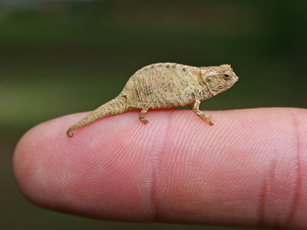Pygmy Chameleon Care Sheet
 Although chameleons are one of the most recognizable creatures to roam this planet, Pygmy chameleons are like the outcast. Not many people seem to recognize them as chameleons. They are small compared to others, ranging from 1 to 3 inches. There are several other very noticeable differences. Although chameleons are one of the most recognizable creatures to roam this planet, Pygmy chameleons are like the outcast. Not many people seem to recognize them as chameleons. They are small compared to others, ranging from 1 to 3 inches. There are several other very noticeable differences.
The first is that Pygmy chameleons are not arboreal. They like to spend much of their time close to the floor of the forest. Pygmy chameleons are brown so they blend in well with dead leaves.
Lighting for Pygmy Chameleons
There is some debate over how to properly provide lighting for a Pygmy chameleon. This debate is brought forth by the belief that since Pygmy chameleons live on the forest floor, they are not as dependant on sunlight for Vitamin D and Calcium as other chameleons. However, I could still safely hypothesize that at least some measure of sunlight still reaches them.
A lot of trial and error tests have been done with UVB lighting. There have been well documented instances of Pygmy chameleons dying within enclosures that did not provide proper UVB lighting. While that's no guarantee that the UVB was directly responsible for these deaths, it's still good practice to be safe.
Combine lighting methods by using both 2% and 5% UVB lighting. Leave the lights on for at least 9 hours a day. It's best to invest in a timer so that you can set these lights to turn on and shut off on their own.
Which Plants Should be Used for Pygmy Chameleons
Since plants make up the bulk of the enclosure, it's important that you plan then carefully. If you are planning to use live plants, then be sure that none of them are toxic to Pygmy chameleons. This is often overlooked since many people don't see chameleons as plant eaters. However, they will munch on plants from time to time. Furthermore, insects might eat those plants. Since the chameleon will eat them next, they will be consuming that same food.
I'm sure that you have already planned out where you want to place all of the plants. Wash all plants thoroughly since many plant suppliers will spray them with insecticides. You should also put them in new soil. While you do have the option of replanting these into the substrate, I recommend that you use pots so that they can easily be removed for cleaning.
Personally, I like to use a mixture of fake and real plants. If you use real plants, make sure the ones you choose are not harmful for your chameleons.
Ideal Temperatures for Pygmy Chameleons
Pygmy chameleons require ideal temperatures to survive. The first step to ensuring the best result is to install both a digital thermometer and a hygrometer into the habitat. This allows you to observe the conditions.
Average Temperature: 70 Degrees
Maximum Temperature: 75 Degrees
Minimum Temperature: 65 Degrees
Humidity: 50% - 60%
Unlike other species of chameleons, Pygmy's do not require a light for basking. That means you will only need to install a basking lamp if your home reaches below 70 degrees.
Humidity will be your greatest concern. Mist the enclosure three times a day in order to keep the humidity levels high at the desired level. Spray bottles work extremely well. Try to mist with water that does not contain chlorine. There are supplements that you can buy to remove chlorine from tap water. Most owners will simply boil the water and let it cool down.
Feeding your Pygmy Chameleon
Again, this is an area where Pygmy chameleons differ from others of their species. You see, Pygmy chameleons all have different tastes. Most tend to prefer crickets but this is not true with them all. However, their differences end at taste. All chameleons require a varied diet made up of several different foods. Some common foods are:
Crickets that are no larger that 1/4 of an inch (7mm).
Fruit Flies since they are small and do not fly.
Wax Worms that are small enough for the Pygmy chameleon to consume.
Small Hatchling Locusts are great for feeding but they will eat plants.
In order to maximize the health of your chameleon, you will need to gut load all insects before offering them as food. Crickets are easy to gut load. All you have to do is feed them carrots, broccoli, or slices of potatoes.
It will be necessary to dust insects with calcium at least once a week. There is also the option of dusting insects with multivitamins. Whatever the case, be sure not to overdo it. Since Pygmy chameleons are so small, they can overdose on calcium and vitamins. For an in-depth guide on identifying, treating and preventing medical conditions, check out "Chameleon Care Guide – Keeping & Breeding Chameleons Made Easy"!

|